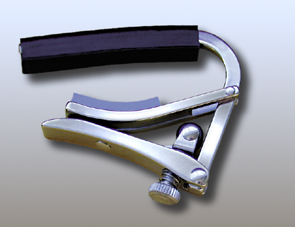Shubb Capos are by far the best for not creating tuning problems. Learn more...

Crafted of solid stainless steel to resist nicks and scratches,
this capo will look just as beautiful years from now as it does today.When the Shubb Capo was first introduced in 1980, capos were elevated to a whole new level. In 1998 the Shubb Deluxe pushed the envelope again. Many people thought that the original Shubb could not be improved, but with the Deluxe we introduced upgrades in materials, design, geometry and ergonomics. It became the flagship product of our line.
$29.95
S1 — for steel string guitar. Fits most acoustics and electrics S2 — for classical guitar. 2.25" wide, flat fretboard. S3 — for 12-string guitar, or any steel string guitar with a wide fretboard. S4 — 7.25" radius fretboard. Fits some (not most) vintage electrics. S5 — for banjo, mandolin, bouzouki. Models for flat or radius fretboard. special model: S3V — for guitars with extra-thick necks)
Frequently asked questions:
• Why are Shubb Capos the best for not creating tuning problems?
Intonation is the feature that really distinguishes Shubb capos from all others. They are designed to close onto the neck just like your hand, and to press the string just like your fingertip, and they are totally adjustable.
Learn more...• Why should I get the Deluxe instead of the Standard capo?
The main difference is material. The Deluxe is made of stainless steel, while the Standard is made of brass and nickel plated. Both are high quality materials. Stainless is harder, so it's more resistant to nicks and scratches. And it has no plating, so if it does get a nick or scratch it can be buffed out.
• How many different models and styles do Shubb Capos come in, and what are the differences?
The "model" refers to what neck shape the capo fits (1, 2, 3 etc.), and the "style" refers to its finish, material, color, etc. (deluxe, Lite, Capo Noir, etc.).
Here is a chart showing all the models and styles.• What is the correct way to apply the capo, from the top (bass side) or bottom (treble side)?
Either is correct. Users seem to be about equally divided, even among the top players.
Read more about applying the capo...• Will the curve of the capo match the radius of my fretboard?
Yes, it will. Although there is some variation in fretboard radii, the curve of the Shubb capo is a good fit for all of them.
How can we be so sure? Learn more...
